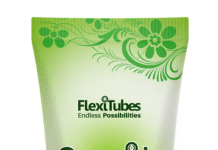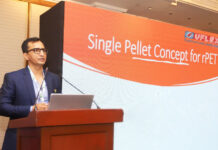bird food
Uflex commissioned their woven polypropylene (WPP) laminate bags project in May 2008 with an initial capacity of 5 million bags (equivalent to about 500 MT of finished laminate) per month at their main plant at Noida near Delhi. This is a new and innovative packaging system that produces packages for specialised market segments in the USA and Europe the segments include pet foods, bird food, domestic feed, chemicals etc. that require bulk packs of 5 kgs to 25 kgs capacity. Major international end-users include people like Procter & Gamble, Nestle, Cargill, General Mills, Walmart and AGS. The system is also now being used for packing premium rice for the domestic Indian market. Work is afoot to introduce it for many new product categories like sugar, flour, cereals and other commodities. Uflex are also launching multiple-use carry bags based on this system. They are the only manufacturer of this system in Asia apart from a couple of Chinese companies.
I visited their new plant for a first hand look at this plant and to discuss their plans for this new project.
The WPP Bag System
The system is a plain or gusseted bag that is made from a high quality reverse printed BOPP film/woven PP fabric laminate. All the inputs and finished bags are made in-house. The basic woven PP fabric is manufactured on a state-of-the-art plant supplied by Lohia Starlinger that starts with the manufacture of PP tapes that are then oriented in the machine direction and then woven into fabrics on circular looms. The tubular fabric is then slit into layflat webs which are coextrusion laminated with reverse rotogravure printed BOPP film. This laminate is then converted into a tubular structure with or without side gussets and then made into bags using either stitching or hot-melt glueing. Accessories like reclosable slider zippers and handles can be incorporated into the bags for convenience. Bags can also be supplied with a pinched bottom construction (side gusset + bottom gusset) to enable them to stand up on their own to facilitate vertical display of the main panels and vertical stacking.
Uflex is the only global manufacturer that offers this entire range of options; all other suppliers manufacture only stitched bags that are not only poorer on barrier but also allow ingress of mites into food products through the stitching. The Uflex bags are very hygienic and suitable for food contact. They are made using only water-jet cooling (as opposed to oil-jet cooling which imparts an oil taint to the fabric) to ensure that the laminate meets the requisite FDA standards.
Uflex have just doubled their bag-making capacity to 10 million bags (equivalent to 1,000 MT of finished laminate) per month. This makes them the world’s largest manufacturer of this hi-tech cutting edge packaging system. Uflex have very ambitious plans for this project. When fully operational, this system will generate revenues of US$ 5 million (INR 250 million) per month, mostly from exports to developed economies. They are also planning to set up a new production facility for this system by 2010 that will be located alongside their new BOPET film project at Altamira in Mexico. This will mainly service markets in the USA, where the current requirements are already 25 to 30 million bags per month (the global potential for this system could be as much as 1 billion bags per month once new developments in the pipe-line fructify). Uflex have already invested over INR 500 million in this project at their Noida facility.
The Production Process
The basic PP granules and additives are extruded through a hi-tech extrusion system that incorporates state-of-the art features like continuous mixing/dosing and filtration, a Maag melt pump and an oscillating gauge sensor that monitors the entire web width and automatically controls the EDI extrusion die with thermal bolts and hex head bolts. The cast sheet is micro slit into tapes that are oriented about 12 times in the machine direction, annealed and wound up on bobbins. The tapes are woven into fabrics on a battery of 6-shuttle circular looms and the tubular output is slit into lay-flat rolls of widths ranging from 700 mm to 1.35 metres as required by the ultimate bag. The weaving capacity is 10,500 kgs per day at 80% efficiency and the entire plant can turn out either PP or HDPE fabrics. The facility is also equipped with quality testing equipment to check denier, tensile strength etc. of the tapes as well as weave quality and strength of the fabric. The fabric plant has already hit break-even levels.
The fabric is then sent to their conversion division (that already does lamination, rotogravure printing in up to 9 colours and slitting/rewinding of various substrates) for lamination and finishing. The fabric is coextrusion laminated to reverse printed 18 to 20 micron BOPP film and then slit as required. The laminate is then taken to their bag-making section where it is first converted into a tubular form with an overlap butt seal using a hot-melt. Side gussets are incorporated where necessary and then the tube is cut off and made into either stitched or heat-sealed bags. Attachments like handles or reclosable zippers can also be incorporated for convenience.
New Innovations
As mentioned above, Uflex were the first to offer both stitched and non-stitched WPP bags. A problem with stitched bags is that they suffer from permeation of oxygen and moisture and ingress of mites through the stitching which causes deterioration of sensitive products and foods. The permeation can be reduced by using smaller stitches but this affects the strength of the joint; in any case, the permeation cannot be totally eliminated. Uflex have overcome the problem by developing hermetically sealed bags using hot-melt closing. Another new development being pioneered by Uflex is a pinched bottom construction consisting of both side and bottom gussets that enables the bags to stand up on the bottom and be stacked in that configuration. This is a big plus as the main front and back panels of the bag become fully available for display and merchandising. Conventional WPP bags do not stand up well on their bottom even if provided with side gussets; this makes it possible for them to be stacked only while resting on the main panels with only the narrow side panels available for display.
According to Amit Ray, President of Uflex’s Conversion Division, “We have gone ahead and made substantial investments in this project. With our innovations, we have established ourselves as the global leaders in this market. We have a lot of ambitious plans for this system.” The core operations team is led by Jeevaraj Pillai — Vice President (Operations), Shashi Garg — General Manager and Business Head of the Big Pouch Division, Joginder Singh Phull — General Manager, WPP Division and Harendra Singh — Executive Manager (Production).
The work done by Uflex in setting up the WPP bag system and in introducing a number of ingenious variants is very impressive indeed. This project will surely become one of the mainstays of Uflex’s operations and establish them firmly as leaders in the global flexible packaging business.










